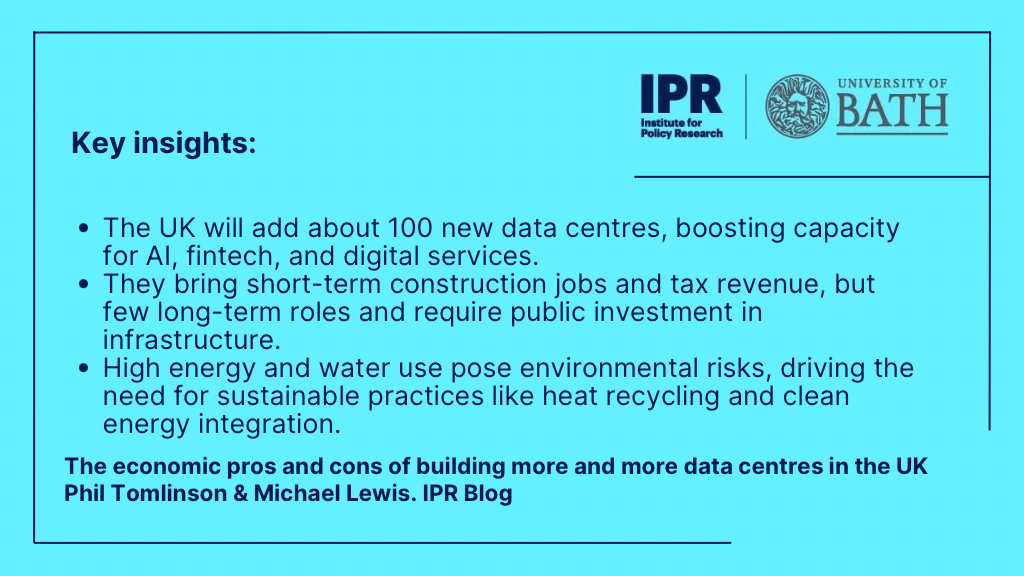The UK plans to build around 100 new data centres, expanding capacity for AI, fintech, and digital services. While this promises economic benefits through construction jobs, tax revenue, and improved digital performance, challenges remain. High energy and water use, infrastructure strain, and environmental impact demand sustainable solutions to balance growth with climate and resource concerns.
Phil Tomlinson is Professor of Industrial Strategy and Co-Director Centre for Governance, Regulation and Industrial Strategy (CGR&IS) at the University of Bath and Michael Lewis is a Professor of Operations & Supply at University of Bath School of Management. This article is republished from The Conversation under a Creative Commons license. Read the original article here.
More direct economic benefits from data centre construction include the thousands of contractors required to build them – as well as opportunities for local regeneration and subsidised skills training.
Operators will also pay business rates, corporation tax and energy levies which all contribute to government revenues. So overall, data centres can certainly do their bit to support the government’s industrial strategy and aims for economic growth.
Power to the processors
But data centres are by no means a golden ticket to prosperity – especially after they’ve been built. The permanent workforce at most data centres is small, with many able to operate with around 20 full-time staff.
Even Blackstone’s massive £10 billion project in Blyth, Northumberland, promises only hundreds of long-term jobs (compared to the 1,200 construction roles).
Data centres also bring considerable environmental costs. Concentrated data centre clusters, such as Slough in Berkshire, which has 14 new sites planned, risk overloading electricity grids. And data centres have so far been major users of non-renewable energy.
Cooling requirements can also be substantial, with some facilities using millions of litres of water every year.
Other environmental concerns include the production and disposal of servers and other IT equipment, the extraction of rare minerals and the generation of electronic waste. These are all factors which may undermine the UK’s ability to implement its net zero policies.
Public investment is likely to be required to reinforce grid capacity and water systems. Such costs will ultimately be paid from tax revenue as well as household utility bills, highlighting one of the economic difficulties that data centres represent – the complex knotting together of public and private investment.
So data centres pose plenty of tricky political and economic questions. How many should there be? What size and where? Who will pay for them?
For now though, the UK government appears to be largely in favour of welcoming more, classifying data centres as “critical national infrastructure”. But it cannot ignore concerns over their environmental impact.
To this end, some cities including London, Leeds and Bristol have begun to pilot schemes to recycle waste heat from data centres to warm homes, which is a promising development.
International intelligence
The UK can also learn from the experience of other countries. In 2022, for example, Ireland’s data centres were consuming 18% of the country’s electricity – a proportion forecast to rise to almost one-third by 2026.
As a result, Ireland has effectively imposed a moratorium on new data centres. The Netherlands now links new data centre approvals directly to clean energy generation.
But data centres have to be build somewhere to meet ever increasing demand. The question is whether the UK can build them fast enough, and on terms that serve its own interests for maximum economic benefit.
Moving too slowly also creates national security risks including a dependency on foreign AI infrastructure and the potential loss of control over sensitive data processing. Jensen Huang, the boss of Nvidia recently described the UK as having “the largest AI ecosystem in the world without its own infrastructure”.
The British government certainly seems keen to develop that infrastructure to strength the country’s digital ecosystem. But it needs to do so in a way which champions a sustainable approach that other nations will follow – and reduces its technological dependence on other countries.![]()
All articles posted on this blog give the views of the author(s), and not the position of the IPR, nor of the University of Bath.
Respond





